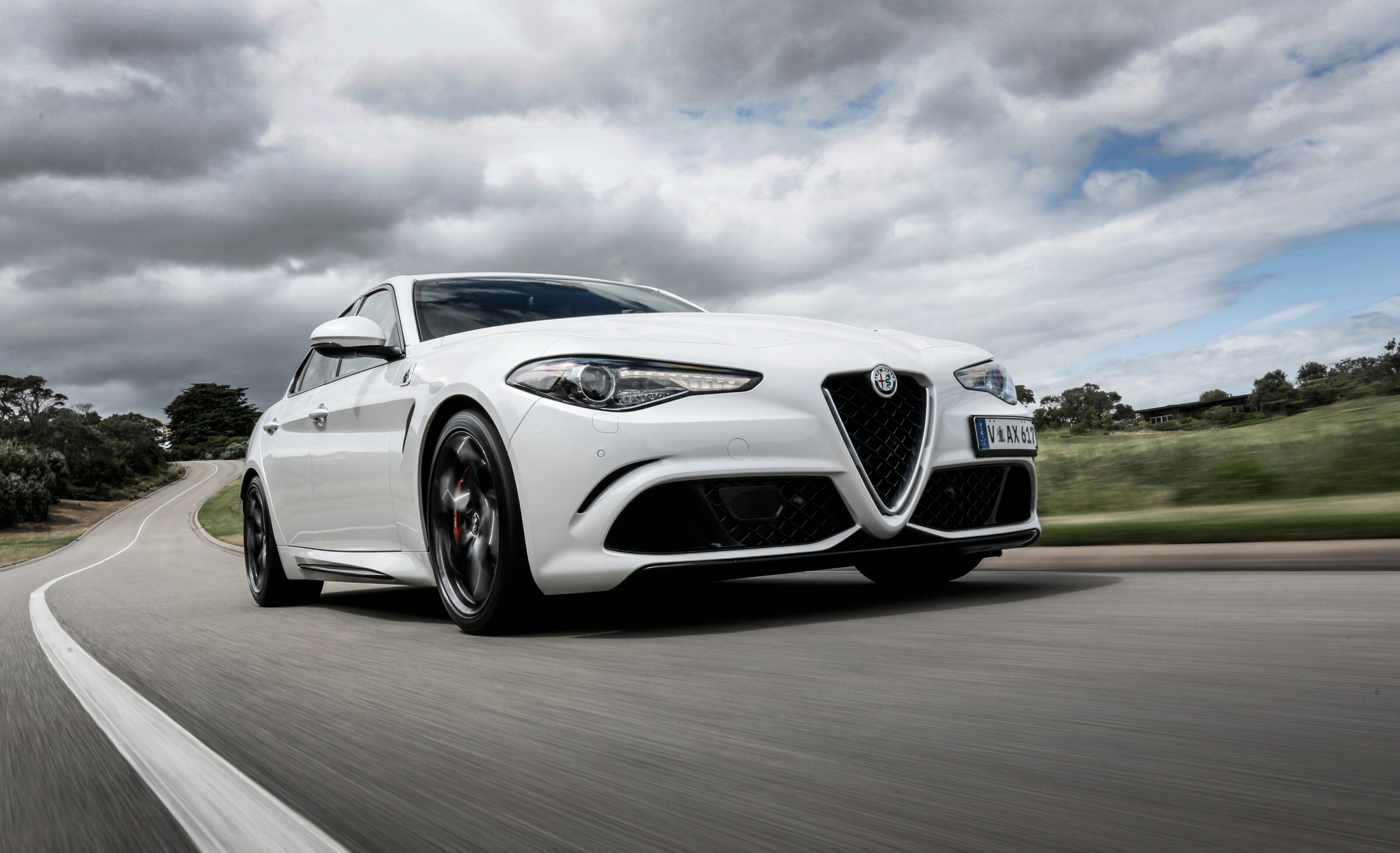Things we like
- Ferrari-derived twin-turbo V6
- Surprising ride quality
- Engaging dynamics
Not so much
- Brake-by-wire needs work
- Rear axle can be bitey
- Getting on in years
If a cursory glance at the 2021 Alfa Romeo Giulia Quadrifoglio’s mid-life update leaves you scratching for signs of change, there’s a good reason for this – it hasn’t changed much at all.
That’s because the handsome and frisky Italian has, over the past four years, proven itself as a fiery, yet everyday-friendly high performer. It’s imbued with an exotic enthusiast appeal, but is increasingly left wanting for techy convenience and safety features. So while it’s relatively slim pickings on the MY21 dynamics menu, it addresses some of the latter stuff.
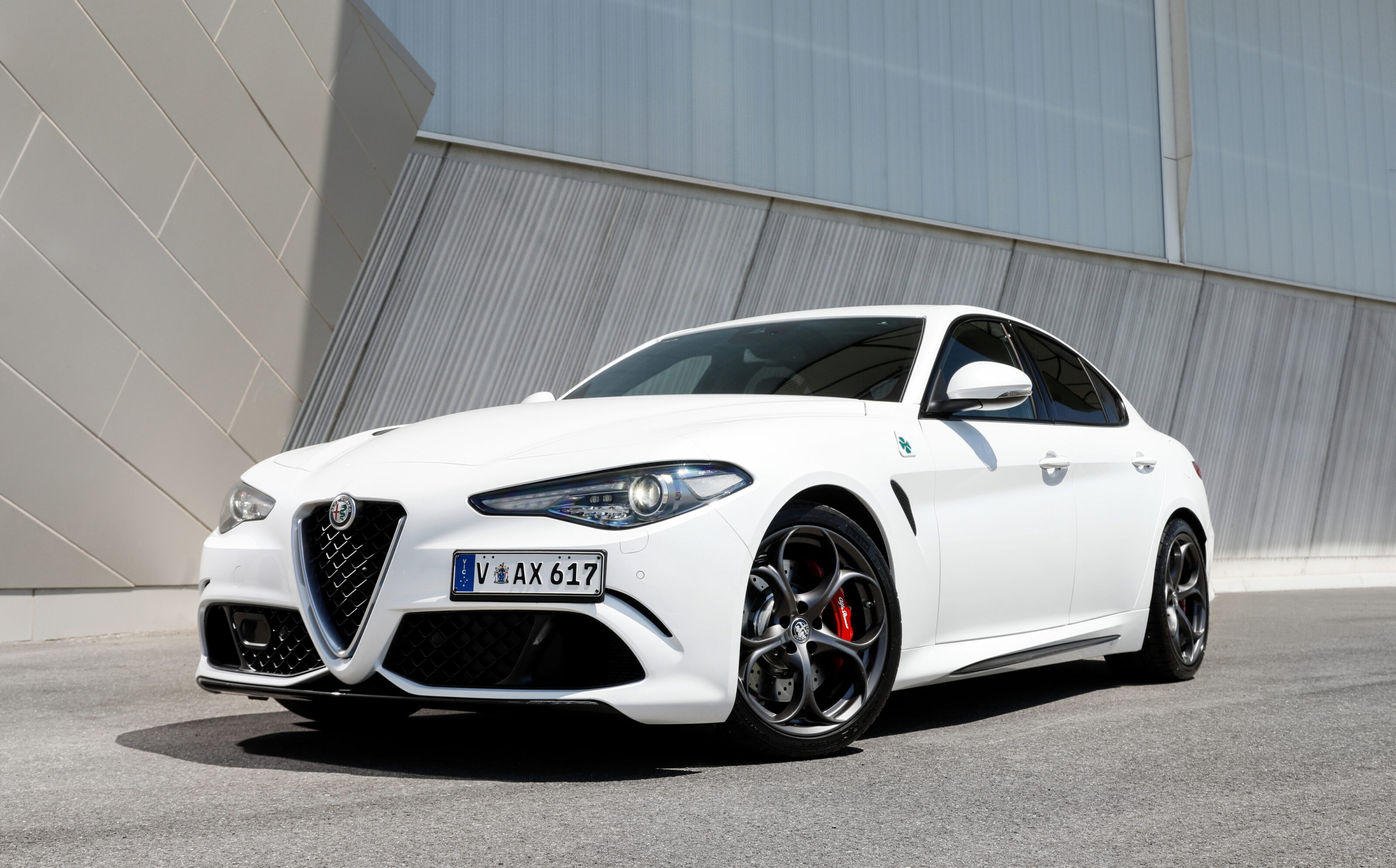
The new 8.8-inch, smartphone-mirroring infotainment system and broader active safety will hardly send the Alfisti rushing to showrooms. That said, it’s a bit of a case of ‘if it ain’t broke, don’t fix it’. But there’s now just a little more sweetener in terms of spec to combat the likes of the box-fresh BMW M3 as well as the stalwart Mercedes-AMG C63 S.
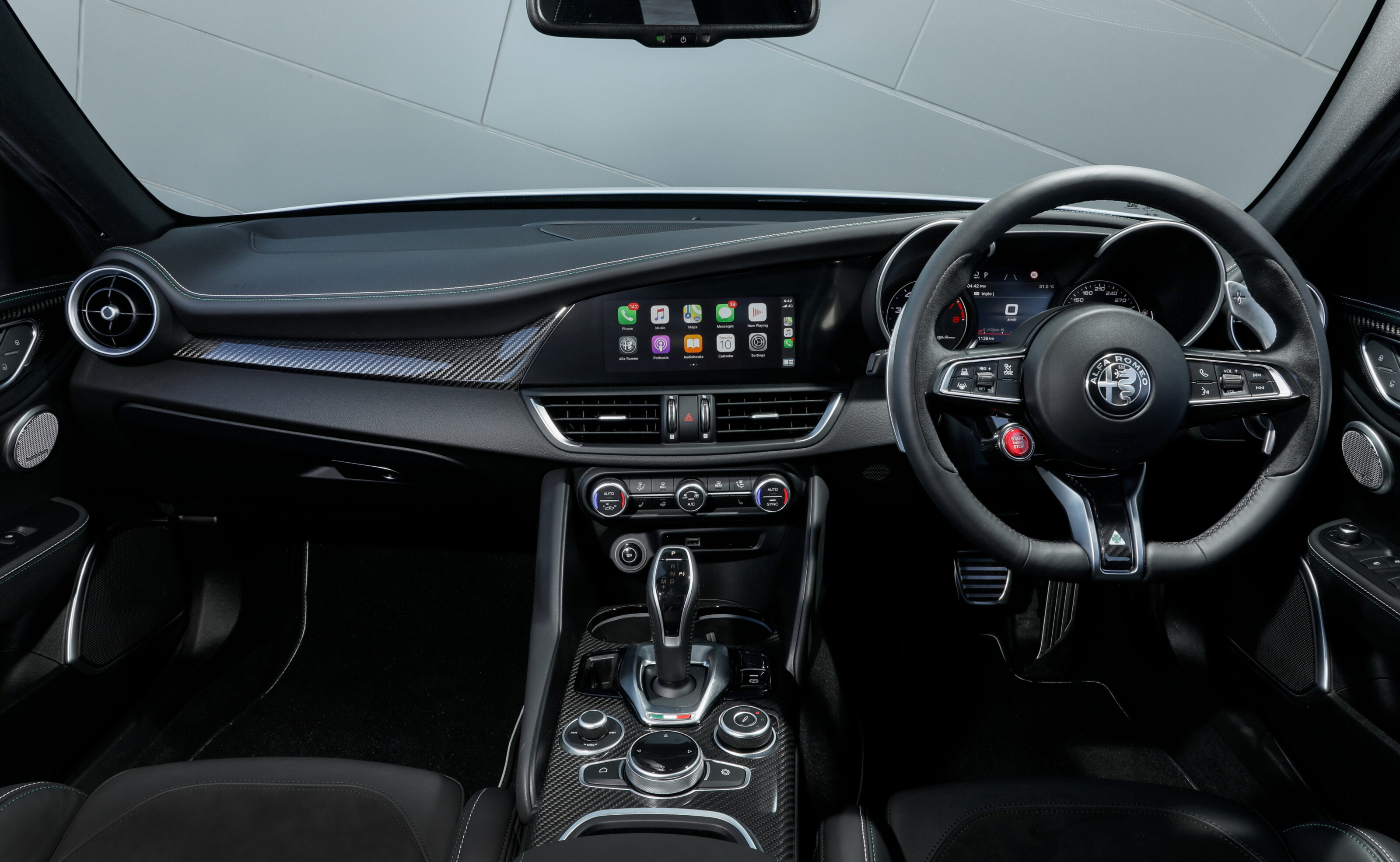
“CLEARLY IT’S A MACHINE HONED MORE FOR REAL-WORLD ROLLING PUNCH THAN THE DRAG STRIP STAND-OFF”
One thing the flamboyant Italian definitely has on its side is price. And now more so than ever, with the hot Giulia receiving an almost $7K cut to its sticker. Admission now starts at $138,950, meaning the Alfa significantly undercuts the $150,900 Audi RS5 Sportback, $154,900 BMW M3 Competition and $168,300 Mercedes-AMG C63 S. Only the ‘base’ manual M3 comes close to the Q at $144,900.
Yes, there’s nothing much new to report in the go-faster department, but then, it didn’t really have to alter. The Giulia’s brutal 375kW and 600Nm 2.9-litre twin-turbo V6 remains unchanged. And thankfully so. Alfa hasn’t felt the need to best its competition by adding more grunt, instead opting to retain the proven package’s heart-warming nature and the metallic-tinged soundtrack like nothing else in its class. It’s a big drawcard, and one of the reasons you should make the near-$140K investment.
It’s still debatable just how much Ferrari DNA courses through its oil galleries – the official line was “Ferrari inspired” and “developed by engineers with a Ferrari background” at the then QV’s 2017 launch. Yet, its finely honed, smooth-revving manner nails the requisite character. It’s virtually lag-free in response and with a more linear delivery than I remember.
Speaking of DNA, dial up Dynamic on the drive-mode controller, trounce the loud pedal and it mounts its peak torque enthusiastically, the assertively clipped upshifts of the tightly stacked eight-speed auto launching it out of the hole hard. It uses stepped-torque in lower ratios to stop the Pirelli P Zero Corsas from scrabbling too much, where it feels a touch stymied, but into third gear and on a roll the thrust is palpable.
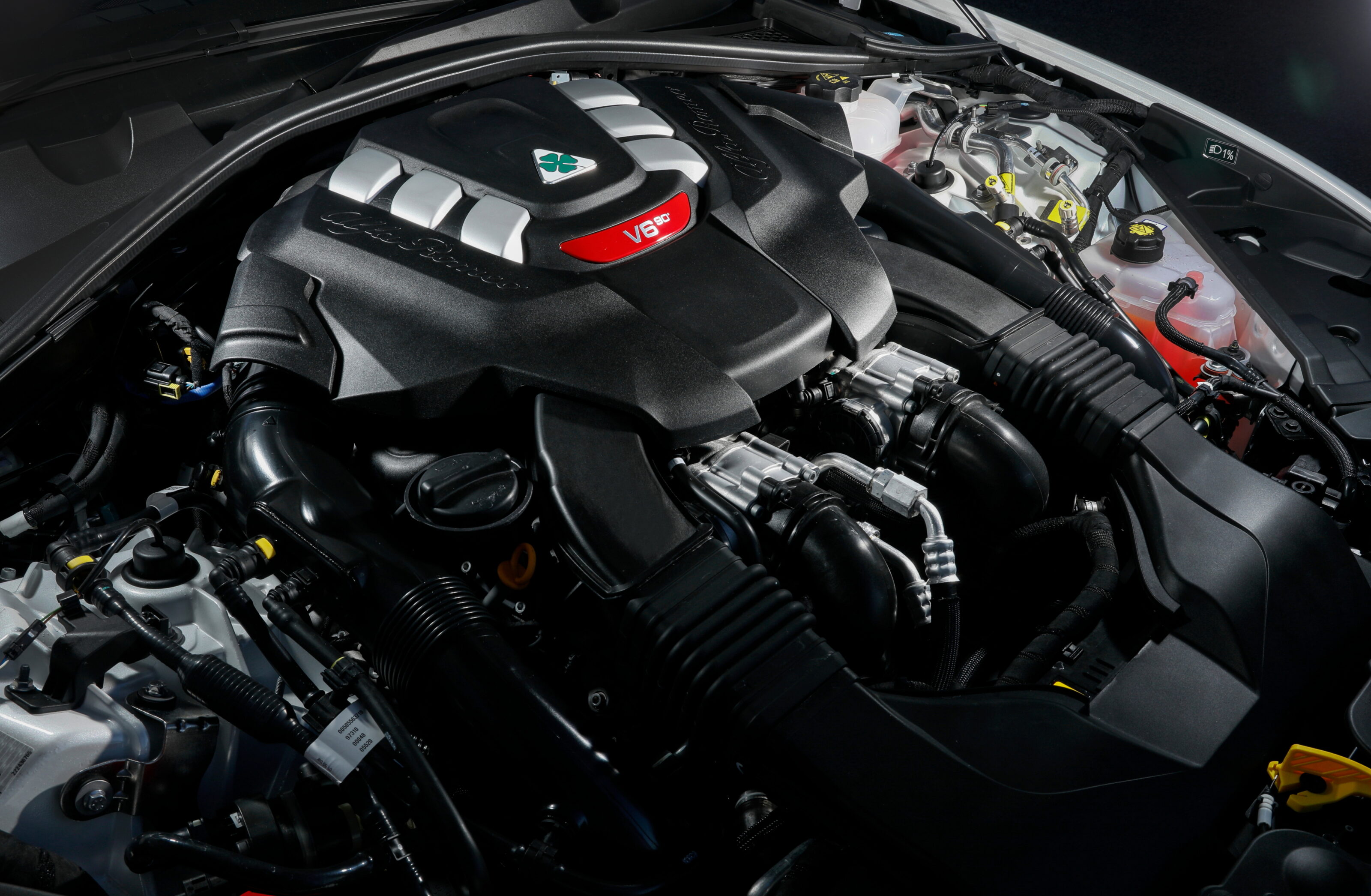
Clearly it’s a machine honed more for real-world rolling punch than the drag strip stand-off and if it can match its 3.9-second 0-100km/h claim I’d like to see (and feel) it. Through the 2018 PCOTY filter, the former QV’s best was a more leisurely 4.3s to 100km/h on its way to a handy 12.2s quarter mile. On the move and on the boil, though, it’s plenty swift by the seat of the pants.
Venture much beyond the 6500rpm redline and thrust tapers off. In fact, its mid-range is such that in-gear punch feels equally as potent, the pace similarly swift with a bit of short shifting. You’re compelled to pause a little longer before selecting another gear once on a twisty road. This is because of the Giulia’s fitment of column-mounted paddle-shifters – though they are lovely long alloy units – rather than a wheel-mounted design. Opinions vary on this, but I prefer ‘em to move with the wheel.
The auto’s manual-shift execution is pleasingly assertive and crisp, although there’s a touch of disobedience in the downshifts if you’re so deep into the brake pedal that the ABS triggers.
As we’ve discovered in the past, if you dial up Race and unshackle the safety nets on track, it’ll liquefy the rear hoops with more enthusiasm than perhaps its Corsas ought to allow. It’s really in this zone, totally uncorked, that the Giulia Q demonstrates just how lively its nature can be and yet just how sublimely co-operative its dynamic talents are.
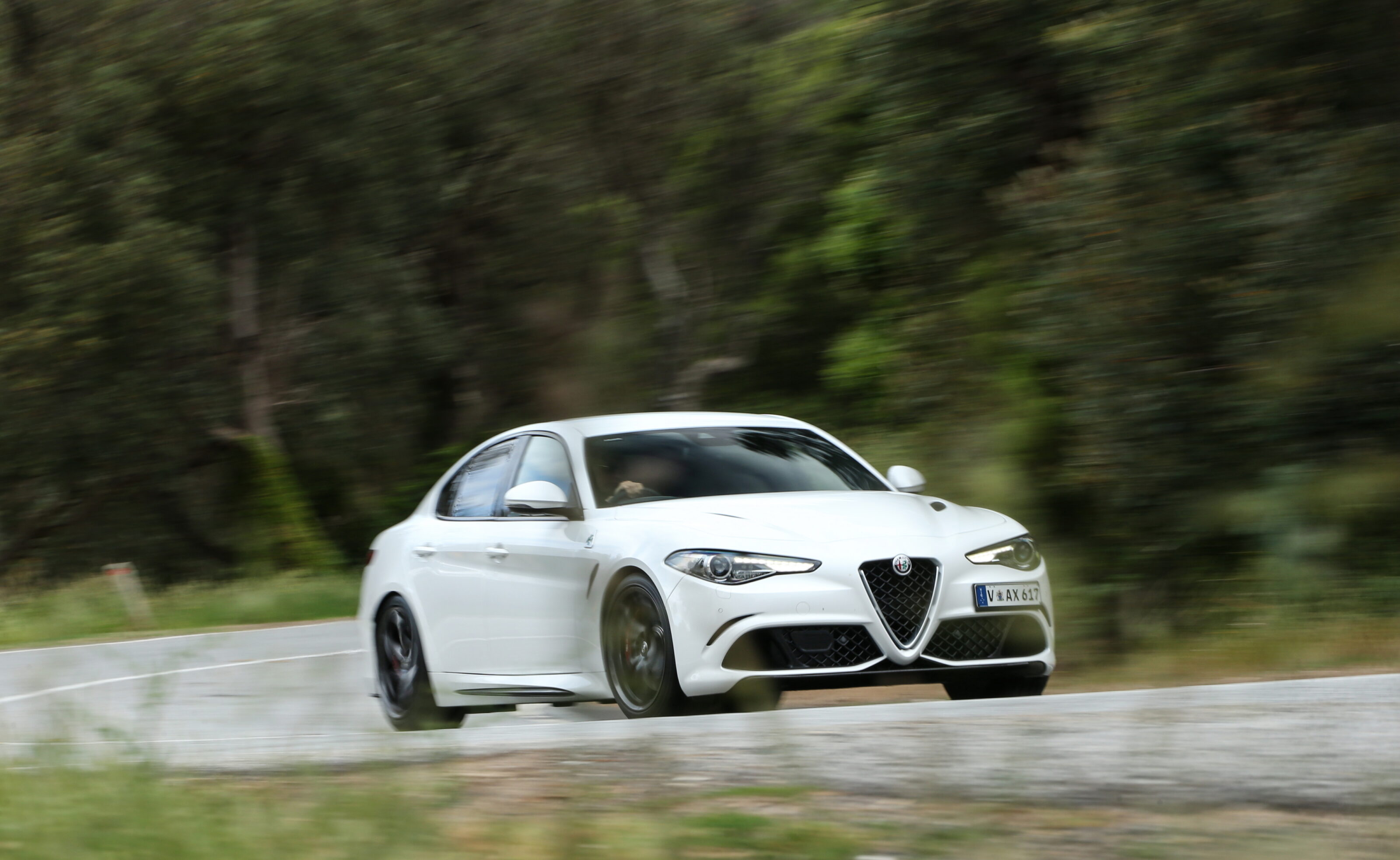
Given that the so-called Chassis Domain Control system works silently in the background tying together the adaptive suspension, torque vectoring, Integrated Brake System and active front aero splitter, its responses are quite convincingly organic. Thing is, there’s plenty of bite to its character, so much so that it does demand the driver to dial into the Giulia Q’s feisty groove.
For its natural 50:50 static weight split there’s an assertive amount of front-end point, meaning it’s hyper alert the instant the steering is a smidgen off centre. It’s keenness to alter its line and trajectory is downright frisky and its confidence to turn in remains faithful and unflappable, even leaning on the nose hard.
The rear end will shimmy in Dynamic or cry for freedom in Race mode depending on your right foot’s level of enthusiasm and there’s ample scope for heroic attitude in between. Both axles are nicely in sync once the tail does get loose, but you must prepare to catch it. Basically, you receive big rewards with serious commitment, though the mid-sized four-door is also amply lithe and engaging when you dial down the heat for spirited back-road punting. Thankfully the Giulia Q rewards with a decent amount of poise and control blended into its overtly adventurous streak.
Maybe more so than its key German rivals, the Alfa rewards in ways the other can’t. It has uncanny compliance, meaning the Giulia Q’s Corsas are capable of maintaining solid adhesion to the road even across abrupt mid-corner bumps. It’s certainly quick and capable between apexes once you build trust in the rear-end grip. The rewards are mega.
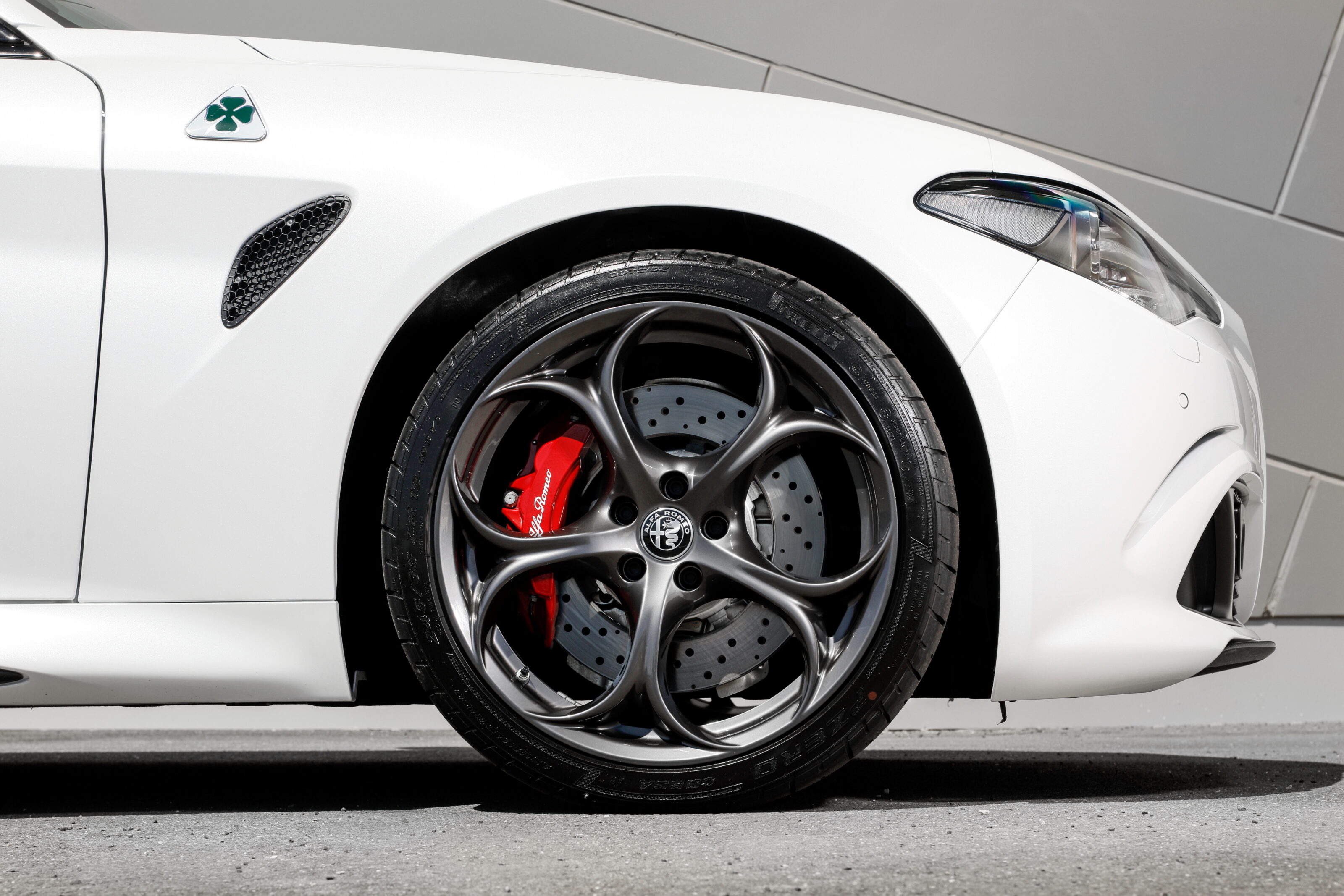
If there’s one area that constantly seems to test trust and confidence even more it’s the brake-by-wire system. The Brembos are certainly powerful enough but, be it the core technology or the way it’s calibrated, their strange wooden feel robs progression and linearity, leaving you second-guessing response and retardation.
I suspect this characteristically foreign brake feel can’t be tuned out of the engineering. The anchors aren’t exactly terrible at pace, but they’re nigh on infuriating during low-speed driving and manoeuvring. It’s been criticised so consistently since the Giulia QV first arrived that, one imagines, it’ll take a new generation donor with wholesale re-engineering to improve upon.
Braking apart, there’s little to complain about in the Giulia Q’s around-town manner. The bi-modal exhaust turns whisper quiet without completely neutering the boosted V6’s spirit, the auto slips sedately and smoothly through the ratios and the powertrain maintains keen response and dignified flexibility when tooling about. The tacho needle often rarely bothers to rise above 2500rpm.
The really impressive bit is the low-speed CBD ride comfort. It’s remarkably adept at smothering general road acne. It’s properly soft and almost limousine-pliant where so many contemporary high-performance sedans only offer a transition from firm to fierce. It’s not so much that the Giulia offers a proper Jekyll-to-Hyde transformation at a twist of the DNA controller, but more that it presents a tangibly wide range between extremes.
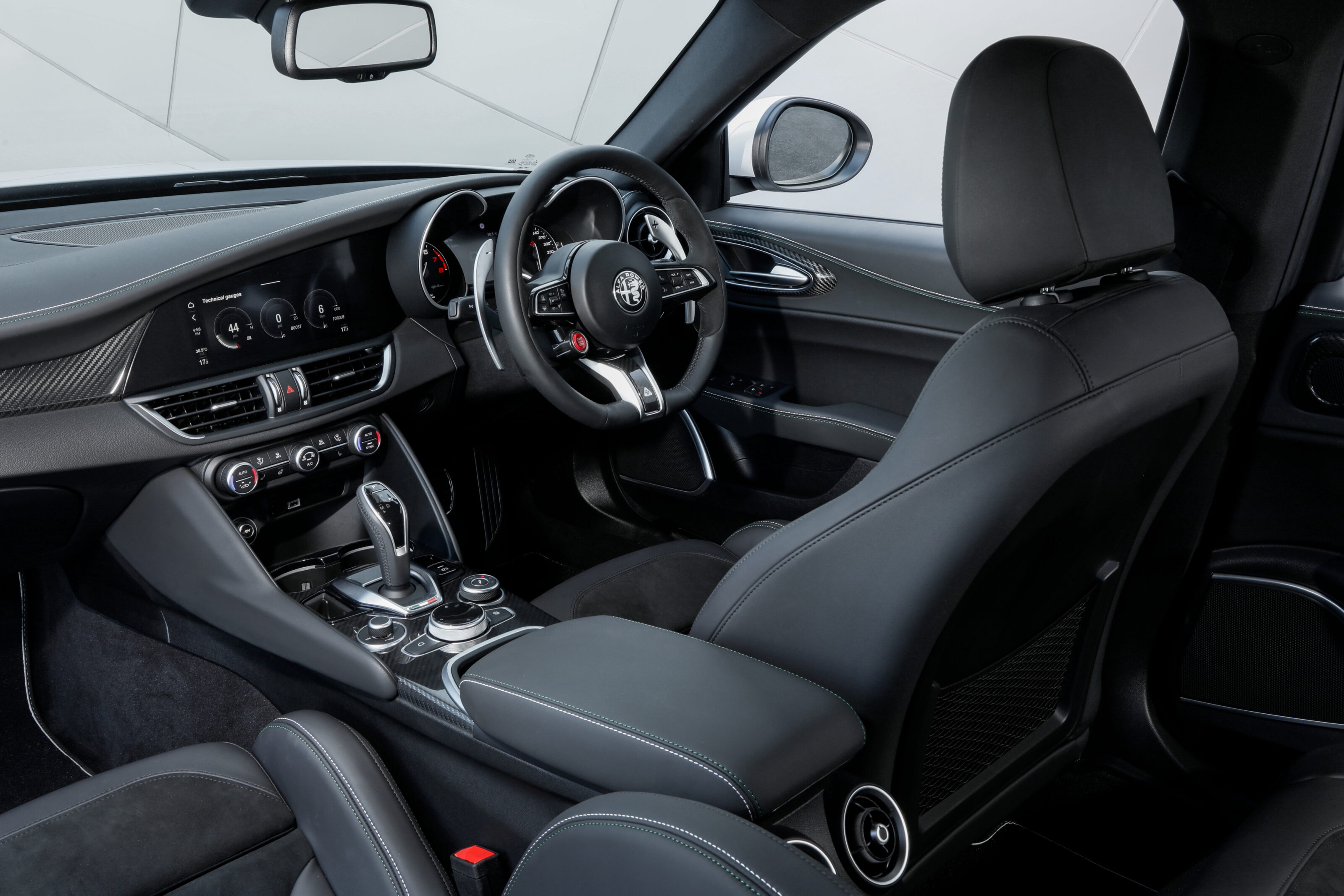
The cabin design is where Alfa Romeo’s renaissance poster child has copped the most flak. Bland and underdone? Perhaps, but the fact it eschews the sort of eye-dazzling digital showboating and overt fussiness its German contemporaries have immersed themselves in isn’t such a bad thing. The Giulia’s analogue-gauged and conventionally staid classicisms mightn’t seem nearly as fancy, but it’s oh-so Italian and perhaps endearingly so to tastes who care little for the Teutonic techno approach.
It’s a proper driver’s cockpit, attaining that feel with great seats, a fetching tiller and control-focused ergonomics. Despite the particularly heavy-handed carbon-fibre work, the Quadrifolgio theme is tempered by restraint and, in some eyes, embodies a certain old-school elegance.
It’s just a shame that many other areas of the interior are a bit ho-hum, including the new infotainment. As one of the Giulia’s few notable updated features, the 8.8-inch touchscreen system is an arm-roll of modest functionality and clarity, complete with a frankly terrible reversing camera. Some areas are substandard for a vehicle of this stature, specifically the flimsy and flaccid feel of the audio and mirror controls.
As mid-life makeovers go, this MY21 touch-up misses the enthusiast gaze if it dares to blink by bringing little new and fixing next to nothing, even if its few changes make for a slightly more pragmatic and safer offering that, importantly, has robbed none of its inimitable character and mojo.
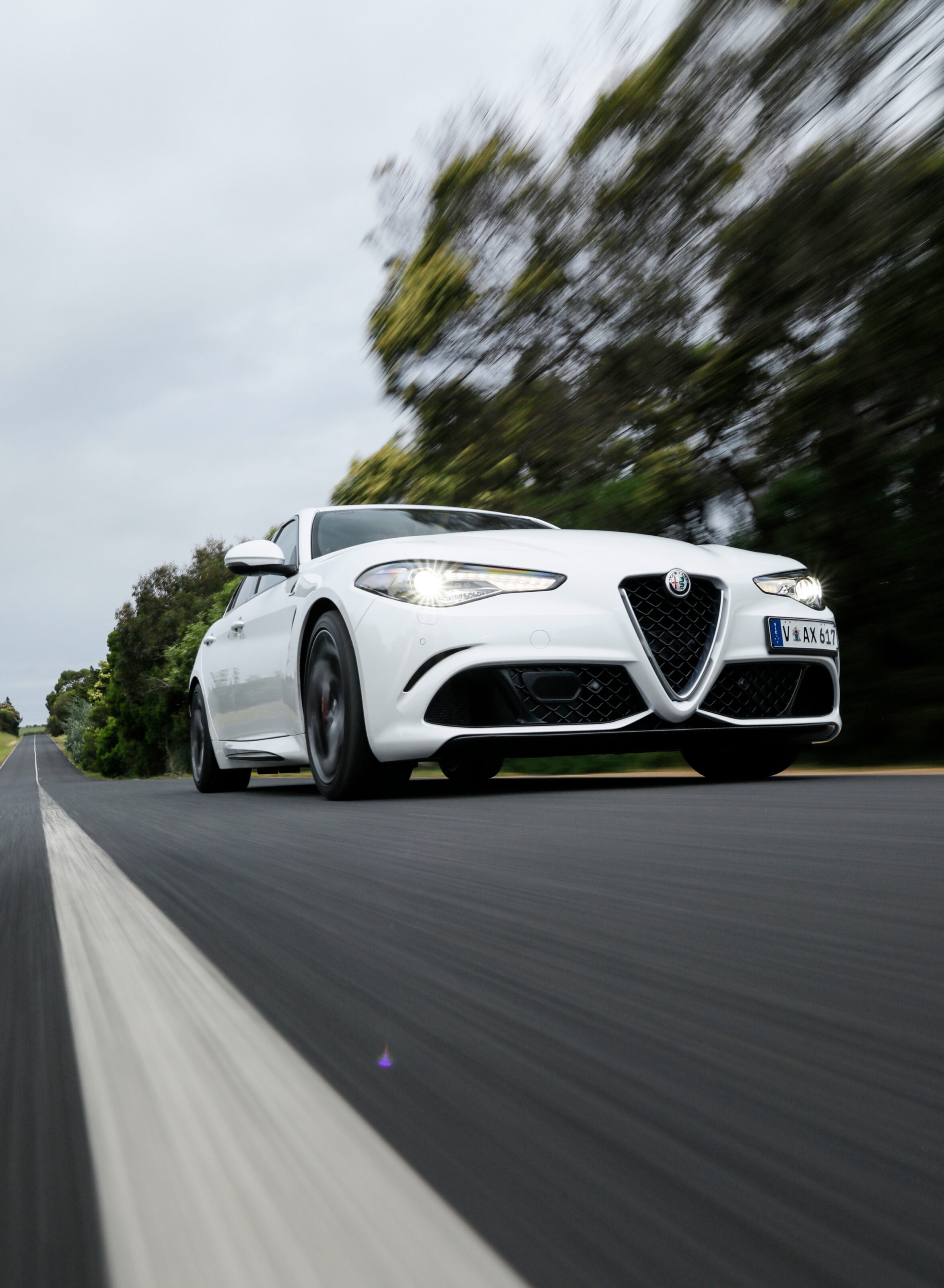
However, what remains the most compelling lure of the Giulia Q’s remit is that the Italian is, in important ways, as much the antithesis of the usual German suspects as it is an alternative.
Despite the obvious resistance to a conspicuous evolution of the breed – safety assistance notwithstanding – the four-leaved firebrand seems to more comfortably occupy its own distinctive patch of the mid-sized high-performance sedan playground four years on.
In some ways, then, the Giulia Q is more appealing than ever.
Things we like
- Ferrari-derived twin-turbo V6
- Surprising ride quality
- Engaging dynamics
Not so much
- Brake-by-wire needs work
- Rear axle can be bitey
- Getting on in years
We recommend
-
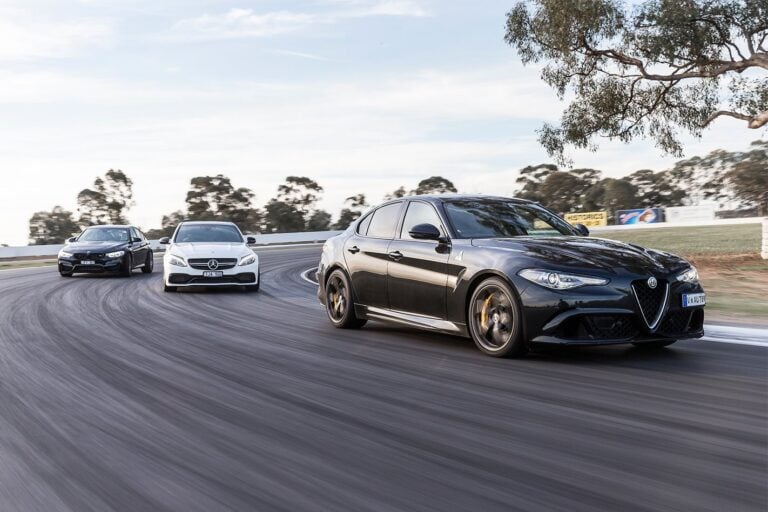 Reviews
ReviewsAlfa Romeo Giulia QV vs Mercedes-AMG C63 S vs BMW M3 Competition comparison
Can Italy's latest super sedan challenge the German establishment?
-
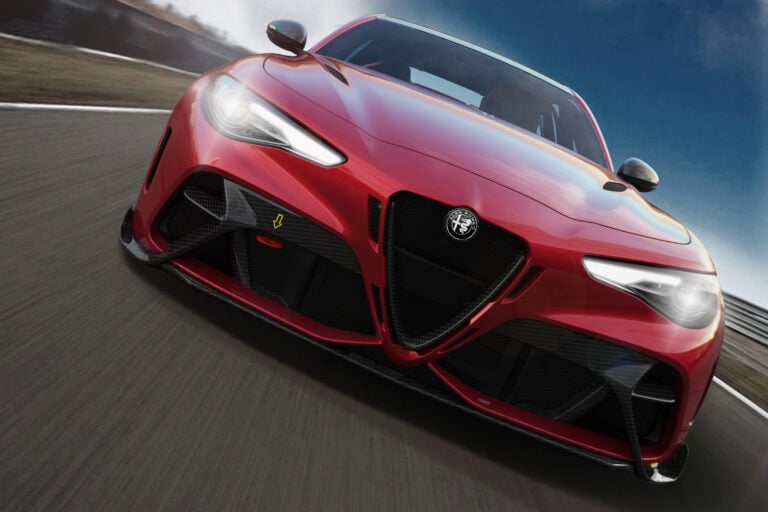 News
NewsAlfa Romeo Giulia GTA, GTAm: Australian pricing revealed
Alfa Romeo’s 397kW street fighter to land in very limited numbers, with eye-watering price tags


